MUSIC GRADE 12 PAPER 1 MEMORANDUM - NSC PAST PAPERS AND MEMOS SEPTEMBER 2017
Share via Whatsapp Join our WhatsApp Group Join our Telegram GroupMUSIC
GRADE 12
PAPER 1
NSC PAST PAPERS AND MEMOS
SEPTEMBER 2017
INSTRUCTIONS AND INFORMATION
- This question paper consists of FIVE sections, namely SECTIONS A, B, C, D and E.
- SECTIONS A and B are COMPULSORY.
- SECTION C: WESTERN ART MUSIC (WAM), SECTION D: JAZZ and SECTION E: INDIGENOUS AFRICAN MUSIC (IAM) are choice questions.
Answer only ONE of these sections (SECTION C or D or E). - Write all music notation in SECTION A in pencil and all written text in blue or black ink. Answer in the spaces provided on this question paper.
- Answer SECTION B and SECTION C or D or E in blue or black ink in the ANSWER BOOK provided.
- Number the answers correctly according to the numbering system used in this question paper.
- The last page of this question paper is manuscript paper intended for rough work. It may be removed by the candidate.
- Use the table on the next page as a guide for mark and time allocation when answering each question.
- Write neatly and legibly.
MARKING GRID
SECTION | QUESTION | MARKS | MARKER | MODERATOR |
A: THEORY OF MUSIC (COMPULSORY) | 1 | 20 | ||
2 | 15 | |||
3 | 10 | |||
4 | 15 | |||
SUBTOTAL | 60 | |||
AND | ||||
B: GENERAL MUSIC KNOWLEDGE (COMPULSORY) | 5 | 20 | ||
SUBTOTAL | 20 | |||
AND | ||||
C: WAM | 6 | 10 | ||
7 | 5 | |||
8 | 5 | |||
9 | 5 | |||
10 | 15 | |||
SUBTOTAL | 40 | |||
OR | ||||
D: JAZZ | 11 | 10 | ||
12 | 5 | |||
13 | 5 | |||
14 | 5 | |||
15 | 15 | |||
SUBTOTAL | 40 | |||
OR | ||||
E: IAM | 16 | 10 | ||
17 | 5 | |||
18 | 5 | |||
19 | 5 | |||
20 | 15 | |||
SUBTOTAL | 40 | |||
GRAND TOTAL | 120 | |||
MEMORANDUM
SECTION A: THEORY OF MUSIC (COMPULSORY) (90 minutes)
Answer QUESTION 1
AND QUESTION 2.1 OR 2.2
AND QUESTION 3.1 OR 3.2
AND QUESTION 4.1 OR 4.2
Answer all the questions in the spaces provided on this question paper.
1. Study the Prelude from Op.28. No. 4 by Chopin below and answer the questions that follow. 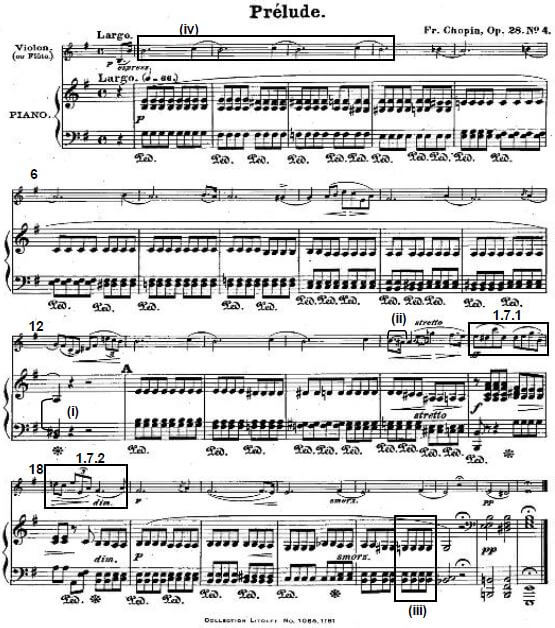
1.1 Name the relative key of the piece.
Answer:
- G major/G (1)
G major/G = 1 mark |
1.2 What does the abbreviation “Op.” stand for?
Answer:
- Opus (1)
1.3 Give the English meaning for the term “Largo”.
Answer:
- In a very slow tempo and with great dignity/very slow and dignified. (1)
1.4 Identify the intervals marked (i) and (ii) complete according to type and distance.
Answer:
- Diminished 5th
- Augmented 2nd (2)
Diminished 5th = 1 mark |
1.5 Invert the interval at (i) and write its correct description underneath it. 
Answer:
- Augmented 4th (2)
Augmented 4th = 1 mark |
1.6 Name the triad marked (iii) according to type and inversion. Re-write it in root position, using semibreves.
Answer:
- Minor triad (3)

Minor triad = 1 mark |
1.7
1.7.1 Transpose the violin part of bar 17 for Clarinet in B-flat. Insert the new key signature.
Answer:
(2)
Correct key signature = 1 mark |
1.7.2 Rewrite the violin part of bar 18 in double the note values. Insert the new time signature.
Answer:
(3)
Correct time signature= 1 mark |
1.8 Identify the compositional technique used to change (iv).
Answer: ![]() (1)
(1)
1.9 1
9.1 Write the E Blues scale ascending, without key signature, in the tenor clef.
Answer: 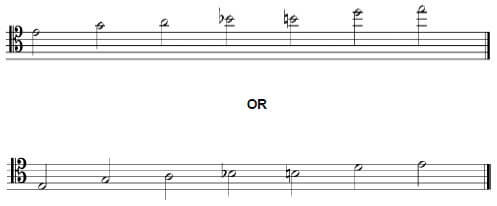 (2)
(2)
Correct clef = 1 mark |
1.9.2 Write the G wholetone scale descending in the alto clef.
Answer: 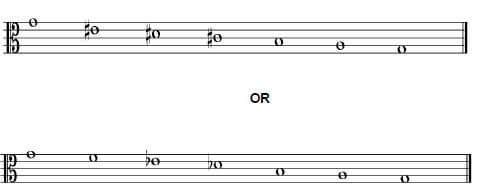 (2)
(2)
Correct clef = 1 mark |
[20]
QUESTION 2 (25 minutes) Answer EITHER QUESTION 2.1 OR QUESTION 2.2.
2.1 Using the opening motif, complete a twelve-bar melody in ternary form for any single-line melodic instrument of your choice. Indicate the instrument for which you are writing, adding dynamics, tempo indication and articulation marks.
Instrument: Flute/ Recorder/Violin/Guitar/Saxophone/Clarinet/Trumpet (Any suitable instrument NOT PIANO.)
Concept answer: 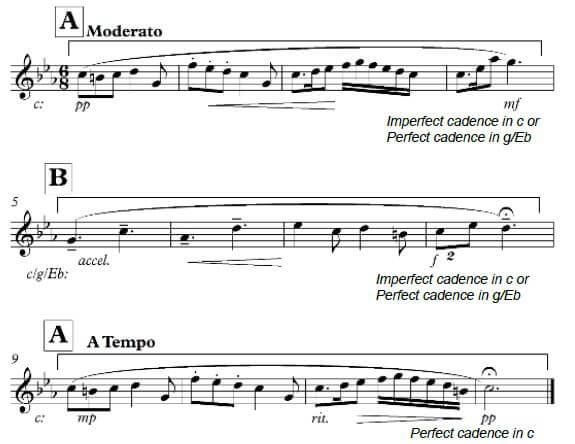
OR
2.2 Use the opening motif below to complete a twelve-bar melody in ternary form for any single-line melodic instrument of your choice. Indicate the instrument for which you are writing and add tempo, dynamic and articulation marks.
Instrument: Cello/Double Bass/Trombone
(Any suitable instrument NOT PIANO.)
Concept answer: 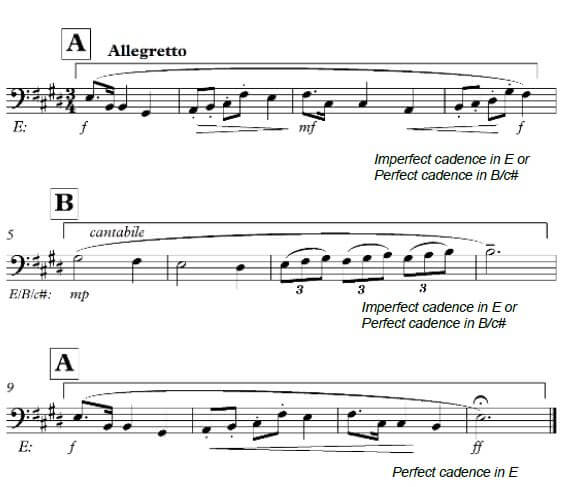
The melody will be marked according to the following criteria:
DESCRIPTION | MARK ALLOCATION | ||
Form and cadential points | 1 mark per phrase x 3 | 3 | |
Correctness | Minus ½ mark per error up to 2 marks | 2 | |
Quality
| 9–10 | Excellent | 10 |
7–8 | Good | ||
4–6 | Average | ||
0–3 | Not acceptable | ||
TOTAL | Markers may use ½ marks | 15 | |
QUESTION 3 (10 minutes)
ANSWER EITHER QUESTION 3.1 OR QUESTION 3.2.
3.1 Study the extract Der Span auf den Wellen from Op. 17 No. 7 by Jean Sibelius below and answer the questions that follow.
Answer: 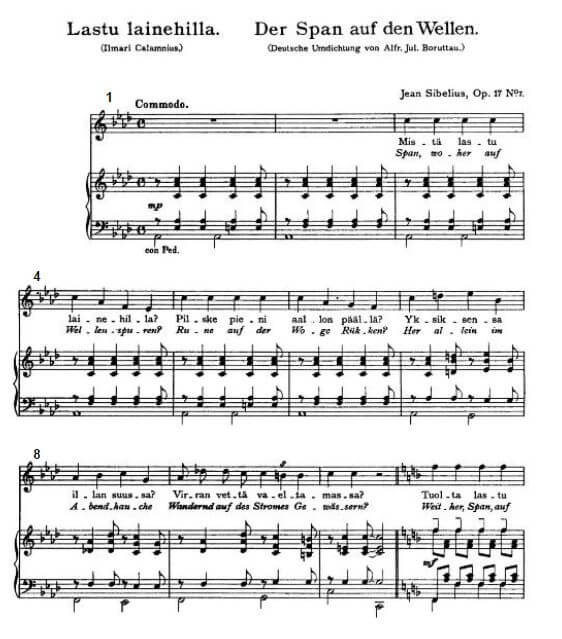
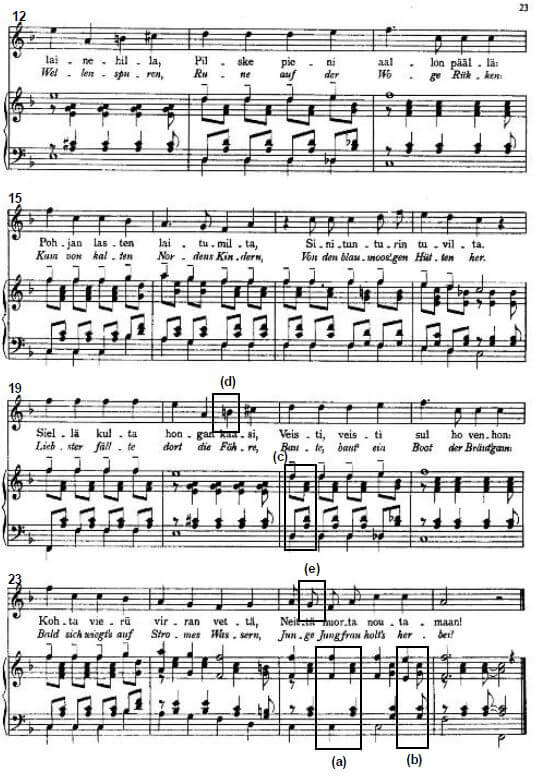
3.1.1 Name the key of the first section of the piece.
Answer:
- Ab major/Ab (1)
Ab major/Ab = 1 mark |
3.1.2 Name the relative key of the second section of the piece.
Answer:
- d minor/d (1)
d minor/d = 1 mark |
3.1.3 Identify the cadence on which the piece ends and write the chords of the cadence, e.g. Interrupted cadence: V – VI.
Answer:
- Perfect cadence: V – I (2)
Perfect cadence/perf. cadence = 1 mark |
3.1.4 Choose the correct answer for the compositional technique that appears regularly in the melody.
Answer: ![]() (1)
(1)
3.1.5 Figure the chords at (a), (b) and (c) complete using Roman numbers, e.g. G: V (or Va) OR chord symbols, e.g. D.
Answer:
- F: I 6/4 or F/C (1)
- F: V or C (1)
- F: vi or Dm (1)
1 mark per chord |
3.1.6 Name the type of non-chordal notes at (d) and (e):
Answer:
(d) Accented passing note (1)
(e) Unaccented passing note (1)
Accented/unaccented = ½ mark |
[10]
OR
3.2 Study the extract below from 15 Easy Pieces for Piano by D. Valeras and answer the questions that follow. 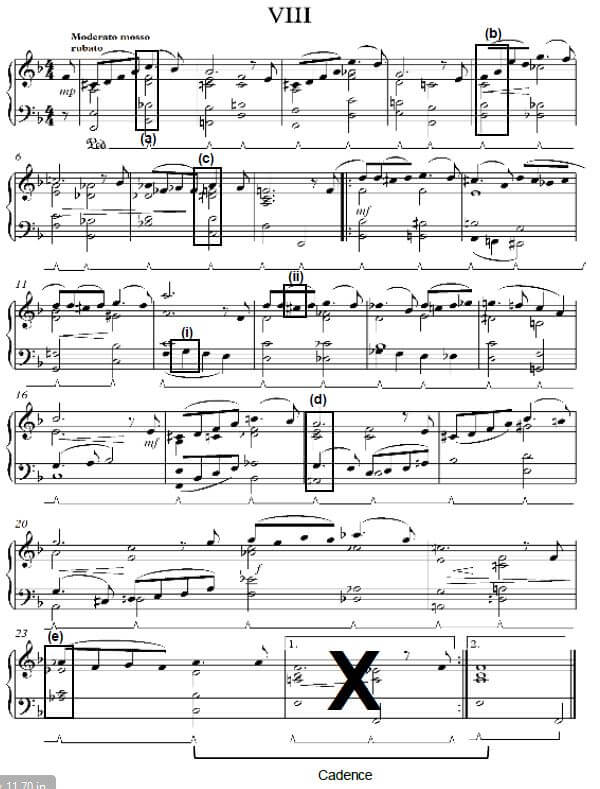
3.2.1 Name the key of the piece.
Answer:
- F major/F (1)
F major/F = 1 mark |
3.2.2 Identify the chords (a) to (e) and number them correctly below. Use chord symbols, e.g. C/E.
Answer:
- Bb9
- Dm7
- C13
- Am7
- Ab (5 x 1) (5)
1 mark per chord = 5 marks |
3.2.3 Name the type of non-chordal notes at (i) and (ii).
Answer:
- (Unaccented) upper auxiliary note
- (Accented) lower auxiliary note (2)
2 correct answers 1 mark each = 2 marks No ½ marks will be given |
3.2.4 Name the cadence at the end of the piece. Identify the cadence by adding the correct chord symbols.
Answer:
- Perfect cadence
- C13(b9) − F (2)
Perfect = 1 mark Chords = 1 mark |
[10]
QUESTION 4 (30 minutes)
ANSWER EITHER QUESTION 4.1 OR QUESTION 4.2.
4.1 Complete the four-part vocal harmonisation below by adding the alto, tenor and bass parts. Use at least ONE non-chordal note in the added parts.
Concept answer: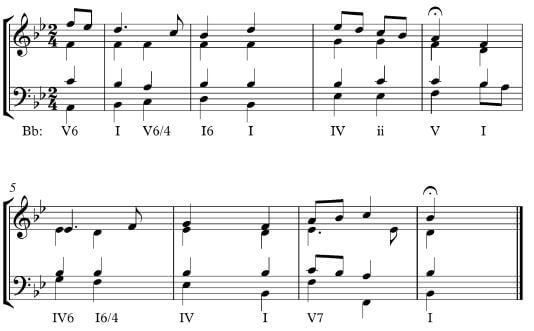
The harmonisation will be marked according to the following criteria:
DESCRIPTION | MARK ALLOCATION | ||
Chord progression | 1 mark between each pair of chords (except between beat 1 and 2 of bar 4). | 14 | |
Correctness | Minus ½ mark per error, but not more than 1 mark per chord. | 16 | |
Quality |
| 9–10 7–8 5–6 3–4 0–2 | 10 |
Note to marker: | 40 (÷ 8 x 3) | ||
TOTAL: | 15 | ||
Candidates must be credited for a different/creative and correct harmonisation not given in the memorandum. The figuring serves as a guide for the marker, but no marks are allocated for the symbols as such.
[15]
OR
4.2 Complete the piece below by adding suitable harmonic material in the bass clef. Ensure that you continue to write in the given style.
Concept answer: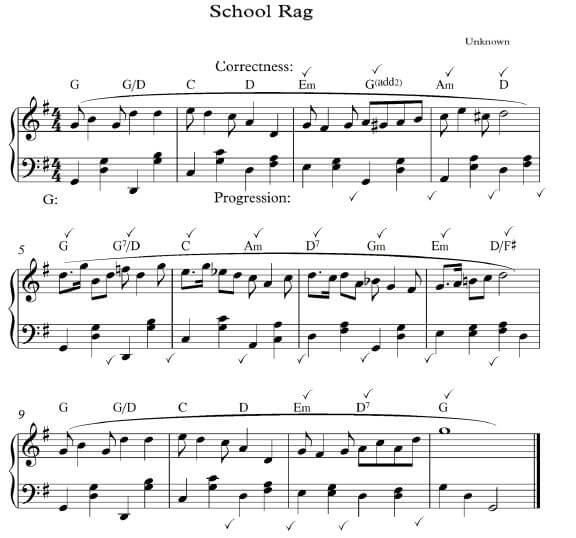
15 marks for correctness
15 marks for progression
The harmonisation will be marked according to the following criteria:
DESCRIPTION | MARK ALLOCATION | ||
Chord progression | 1 mark between each pair of chords | 15 | |
Correctness | Minus ½ mark per error, but not more than 1 mark per chord. | 15 | |
Quality |
| 9 – 10 7 – 8 5 – 6 3 – 4 0–2 | 10 |
Note to marker: | 40 (÷ 8 x 3) | ||
TOTAL: | 15 | ||
Candidates must be credited for a different/ creative and correct harmonisation not given in the memorandum. The figuring serves as a guide for the marker, but no marks are allocated for the symbols as such.
[15]
TOTAL SECTION A: 60
SECTIONS B, C, D, E: GENERAL MUSIC KNOWLEDGE (90 minutes)
Answer SECTION B
AND SECTION C (Western Art Music)
OR SECTION D (Jazz)
OR SECTION E (Indigenous African Music)
Answer these in the ANSWER BOOK provided.
Note to marker: One mark will be allocated for each correct fact. Candidates must be credited for any correct answer not given in this memorandum. |
SECTION B: GENERAL KNOWLEDGE (COMPULSORY)
QUESTION 5
5.1 Four options are provided as possible answers to the following questions. Choose the correct answer and write only the letter (A–D) next to the question number in the ANSWER BOOK, e.g. 5.1.12 E.
5.1.1 C
5.1.2 A
5.1.3 C
5.1.4 D
5.1.5 D
5.1.6 A
5.1.7 D
5.1.8 B
5.1.9 C
5.1.10 B (10)
1 mark for each correct answer = 10 marks |
5.2 Answer the following questions.
5.2.1 Describe shortly what the music industry entails.
- The music industry entails various steps that are followed to get the product from the producer to the consumer. (1)
Correct answer = 1 mark |
5.2.2 Define needletime rights.
- It is royalties paid to recording artists when a song is used.
These are the people who help in the recording of music – such as backing vocalists, musicians, etc. These royalties are paid when a song is played/recorded/performed. (1)
Correct answer =1 mark |
5.2.3 Give a short description on how music royalties work.
- Songwriters register their work/songs at SAMRO. SAMRO has licenses over those works/songs that can be sold to people in order to collect money for songwriters. People that buy licenses from SAMRO include TV stations, radio stations, Internet websites, restaurants, stores, etc. The money collected from these businesses, is distributed between all members of SAMRO, depending on the airtime they attained. SAMRO determines airtime by requesting written information from live venues, television stations and radio stations. (2)
Any 2 correct facts = 2 marks |
5.2.4 How many years must lapse after the death of a composer, for his/her works to become public domain, unless the copyright is renewed by family?
- 50 years (1)
Correct answer = 1 mark |
5.3 Give the Italian term for the following description:
5.3.1 To play a specific passage of music with fire and vehement energy.
- Con fuoco (1)
Correct answer = 1 mark |
5.4 Name TWO very specific style characteristics of the music of Beethoven.
- He was the master of thematic material and he used the following 2 types: 1st themes were broken up into short motives – 1st movement of Symphony no. 6; Cantabile melodies were found in the last movement of Symphony No. 6. He used the old contrapuntal practices and was a master of this.
In Form, he was a master at using thematic development, he expanded the sonata form. He used Free Fantasy in the 1st movement of Moonlight Sonata. He exceeded the limits of the choral idiom, treating his chorus as additional instrumental colour – Symphony no. 9. He developed the use of harmony by using heavy thick chords and modulations to other keys than subdominant and dominant keys. (2)
Any 2 correct facts = 2 marks |
5.5 Describe the difference between sonata and sonata form.
- The sonata has 3 sections: exposition, development and recapitulation. The sonata usually ends on a coda (Italian for “tail”). Although it has a breakdown into what looks like three movements; it is actually a single movement structure. (2)
Do not confuse it with a sonata, which is a complete composition made up of different movements.
1 fact for sonata form = 1 mark |
TOTAL SECTION B: 20
Answer SECTION C (WAM)
OR SECTION D (JAZZ)
OR SECTION E (IAM).
QUESTION 6
6.1 Define the following:
6.1.1 Grand opera
- It is a spectacular opera, with the plots based on or around dramatic historic events. It involved royalty, heroism, ballet scenes and are long, normally four or five acts. It is characterised by large-scale casts and orchestras. (2)
Any 2 correct facts = 2 marks |
6.1.2 The development of instrumentation in the Romantic era.
- A huge accent on broadening the range of instrumental colour and diversity. The string section was lengthened. The instruments played deep expressive melodies. Orchestral players had to adapt tone colour to individual composer’s style. Technical virtuosity was improved to meet the demand of the music and the public. (2)
Any 2 correct facts = 2 marks |
6.1.3 Alberti bass
- The bass line was now only the accompaniment, called the Alberti bass – the breaking of the chords into a simple pattern and it is then repeated. Albert bass is a type of broken chord or arpeggiated accompaniment. (1)
Correct answer = 1 mark |
6.2 What is the significance of the number three in Mozart’s opera, Die Zauberflöte?
- It was as a result of the influence of the Freemasons. (1)
Correct answer = 1 mark |
6.3 Name TWO examples which feature the number three in Die Zauberflöte.
- It represents the 3 knocks on the door by entering the Masonic meetings: 3 ladies; 3 youths; 3 geniis; 3 temples; 3 trials; Home key (E flat major with its 3 flats); Repeated idea – short-long-long – in overture and 2nd Act; 3 heavy chords that open overture, again repeated in temple scene when Tamino’s trials begin; Setting in Egypt – rites of Freemasonry. (2)
Any 2 correct facts = 2 marks |
6.4 Describe ONE technique used to change the theme when composing in Theme and Variation style.
- Composers removed notes, added notes, changed key, harmony, rhythm, repeat with different accompaniment patterns. Composers often improvised on given theme during concert – impress them with their skills – a person from audience would suggest theme, composer would then improvise in as many ways as possible. (1)
Any one correct fact = 1 mark |
6.5 Why is Beethoven’s Symphony No. 6 Opus 68 in F major different to other symphonies?
- It has 5 movements, instead of the normal 4 movements.
- The last 3 movements are played without a break.
- It contains explicitly programmatic content.
- The 6th Symphony is one of only two symphonies Beethoven intentionally named. (1)
Any one correct fact = 1 mark |
[10]
QUESTION 7
7.1 Name THREE characteristics of the opera music of the Florentine Camerata.
- The Camerata wanted to develop a new vocal style modelled on the music of the ancient Greek tragedy, who based their theories on literary accounts that survived. The music was more important than the text. The Camerata stated that music should always be the servant of the text. They avoided any polyphonic treatment and made little use of the aria and chorus. They composed short vocal pieces called monodies – the singer was given a melodic setting of text supported by instrument that provided a simple chordal bass accompaniment and singer could sing the rhythm of the text in accordance with natural rhythms of the text. The vocal line followed the rhythms and pitch fluctuations of speech – this later became known as recitative (recited). The recitative was sung by a soloist with a simple chordal accompaniment. The texture of the music was homophonic. (3)
1 mark each for any 3 correct facts = 3 marks |
7.2 One of the most important opera composers was Monteverdi. Explain th meaning of this statement.
- Along with the Camerata was one of the greatest opera composers, known as the founder of the opera, namely Claudio Monteverdi (1567−1643). His 1st great true opera, L’Orfeo, set the standard for other European composers and helped to establish their national traditions in the 17th century. His opera contained recitatives, choral works, instrumental dances, interludes (later known as ritornelli). Monteverdi expanded the function of the orchestra, using a larger variety of instruments and also more singers than his predecessors. Monteverdi captured the meaning of the text in the music. He became master of the new homophonic dramatic style. (2)
1 mark for 2 correct facts = 2 marks |
[5]
QUESTION 8
8.1 Compare Singspiel with Music Drama. Name TWO differences and ONE similarity regarding the style types.
Similarities:
- Both Singspiel and Music Drama are sub-genres of the opera.
- Both are a form of opera.
Differences:
Singspiel | Music Drama |
|
|
|
|
|
|
|
|
|
|
|
|
|
|
1 similarity (correct fact) = 1 mark |
[5]
QUESTION 9
9.1 Write a short description about the significant elements of the second theme of “Fingal’s Cave” regarding the instrumentation.
- The second theme, meanwhile, depicts movement at sea and “rolling waves”.
- It is written in D major and scored for bassoons and cellos.
- The theme is first played by the cellos and bassoons in D major.
- The change from minor to major create a sunnier mood.
- The theme is accompanied by strings playing soft semiquavers and this repetition of the semiquavers create the idea of a calm sea. (5)
1 mark for each correct fact = 5 marks |
QUESTION 10
Write an extensive article for your school newspaper regarding the FOURTH and FIFTH movements of Beethoven’s Symphony No 6, opus 68. Discuss, amongst other facts, the use of the instruments to show the events taking place in nature.
- The FOURTH movement is called “Thunderstorm” and the pace is Allegro and a punctuated half-note = 80. It is written in F minor, the time signature is 4/4 and is in free single-form, comparable to program music with interesting orchestral colors. In this movement Beethoven adds the following instruments to the "classical" orchestra – a piccolo, flute, Clarinet in Bb, bassoon, Horn in F, trombone (alto and tenor), timpani and other stringed instruments. Beethoven also creates an ongoing music flow by moving sections and motives from one instrument or instrument group to another. In this way, timbre has started to play an important role.
The movement depicts a violent thunderstorm with painstaking realism, building from just a few drops of rain to a great climax with thunder, lightning, high winds, and sheets of rain. The storm eventually passes, with an occasional peal of thunder still heard in the distance.
The role of the instruments is very important. The violins play pp staccato quavers give effect of first raindrops. The drums represent the 1st big roll of thunder with low quintuplets in the cellos and quadruplets in the bass, giving a rumbling effect. When the piccolo enters in Bar 82, it strengthens the storm. 2 Trombones in bar 106 give additional strength to the climax of the storm. Upper strings play ff tremolos, giving the feeling of intense excitement. The storm reaches its climax with drum rolls and tremolos. The music gradually becomes softer after the storm when the quavers re-appear as dolce minims in the oboe over a dominant pedal point in tonic key. The thunder is still heard in the distance.
This movement has many romantic elements – dynamic contrasts, harmonic colours, melodic continuity, and freer form structure. There is a seamless transition into the final movement. This movement parallels Mozart's procedure in his String Quintet in G minor K. 516 of (1787). The tempo indication is Allegro and a dotted minim = 80. It is composed in F minor. The time signature is 4/4. The form is Programme music (or free on-part form) with interesting orchestral colours. Beethoven added new instruments – Piccolo, Flute, Oboe, Clarinet in Bb, Bassoon, Horn in F, Trombones (alto and tenor), Timpani and strings.
The FIFTH movement is the finale and is called the ‘”Shepherd’s song – Happy and grateful feelings after the storm.” The pace is Allegretto and a punctured quarternote = 60. It is written in F major and is in sonate round form (7-leaf round shape). The main theme is in the tonic key at the beginning of the development, as well as in the exposition and recapitulation.
This movement is the final. Like many classical finales, this movement emphasises a symmetrical eight-bar theme, in this case representing the shepherds' song of thanksgiving. As the storm moves away, there is a feeling of relief and all the animals emerge.
The 5th movement starts with a yodel “Ranz des Vanches” (a simple melody played by the horn of the Swiss Alpine herdsmen when they drove their cattle to or from the pasture), played by the clarinet and imitated by the horn over dominant and tonic harmonies, softly played together by the strings. Beethoven uses the same "extra" instruments as for the fourth movement, leaving out only the piccolo.
The coda starts quietly and gradually builds to an ecstatic culmination for the full orchestra (minus "storm instruments"), with the first violins playing very rapid forte triplet tremolo on a high F. There follows a fervent passage suggestive of prayer, marked by Beethoven "pianissimo, sotto voce"; most conductors slow the tempo for this passage. After a brief period of afterglow, the work ends with two emphatic F major chords.
The key is F major and the time signature is 6/8. The form is sonata rondo form, meaning that the main theme is in tonic key at the beginning of the development as well as the exposition and the recapitulation. Beethoven used the same instruments as for the Thunderstorm, except for the piccolo − Flute, Oboe, Clarinet in Bb, Bassoon, Horn in F, Trombone, and Strings. (15)
[15]
The essay will be marked according to the following criteria:
CRITERIA | MARK ALLOCATION | ||
Fourth movement: | 1 mark for each correct fact x 6 | 6 | |
Fifth movement: | 1 mark for each correct fact x 6 | 6 | |
Logical presentation and structure of the essay | Excellent | = 3 marks | 3 |
Good | = 2 marks | ||
Average | = 1½ marks | ||
Below average | = 1 mark | ||
Weak | = ½ mark | ||
Not acceptable | = 0 mark | ||
TOTAL: | 15 | ||
TOTAL SECTION C: 40
OR
SECTION D: JAZZ
QUESTION 11
11.1 Choose the correct answer from COLUMN B to match the statement/name in COLUMN A. Write only the correct matching letter (A–F) next to the question number in the ANSWER BOOK, e.g. 11.1.7 G.
11.1.1 E
11.1.2 D
11.1.3 F
11.1.4 B
11.1.5 A
11.1.6 C (6)
1 mark for each correct answer = 6 marks |
11.2 Name TWO similarities between Mbaqanga and Marabi.
- Swing and Kwela (2)
2 correct facts = 2 marks |
11.3 With which instrument is Marabi associated?
- Pedal organ (1)
1 mark for correct answer |
11.4 The “Merry Blackbirds” enjoyed playing the music of American ragtime, as well as written jazz arrangements. Name ONE artist whose arrangements they played.
- Louis Armstrong, Duke Ellington, Count Bassie, Sy Oliver (1)
Any correct answer = 1 mark |
[10]
QUESTION 12
12.1 Write a paragraph, describing the Marabi style of The Jazz Maniacs and their influence and contribution of Solomon Cele in the development of the style.
- It reflected political goals in the USA and SA. It was developed in Sophiatown and District Six. The band consisted of the self-taught pianist, Solomon Cele. He listened and imitated the shebeen music. The band started with 4 members and increased to 13. The other instruments were saxophone, guitar, and trombone. Cele said the swing-sound was ideal to transfer his music ideas and they combined jazz, swing and local melodies. All of this led to the development of Marabi. The band would take musical ideas of some American bands and made it their own instead of just copying it. Their music was influenced by Louis Armstrong, Buck Clayton and Harry James. (3)
1 mark each for any 3 correct facts = 3 marks |
12.2 Describe New Jazz in a short paragraph and name ONE important artist of this style.
- The New Jazz style refers to the development of South African Jazz after the 1950’s. It was not derived from Marabi or Kwela and did not fit in to the Mbaqanga category. The musicians developed their own highly individualistic/independent styles.
Artists: Todd Matshikiza, Gideon Nxumalo, The Jazz Epistles,(2)
Philip Tabane
1 correct fact = 1 mark 1 |
[5]
QUESTION 13
13.1 What was the origin of Kwela music? How did Kwela influence the music scene in South Africa?
- Kwela is a South African jive style, derived from Marabi. The most significant instrument is the pennywhistle, which was later replaced by the saxophone. The music was played on the streets by township youths. This was the birth of new, lively music that did not require much money. Pennywhistle kwela or Kwela is a historical turning point in the development of popular African music and jazz in South Africa. The pennywhistle was a small instrument and thus easy to carry around. As shepherd boys moved from the rural areas to the cities, they took their pennywhistles with, but later replaced them with a German produced one. Typical instruments for Kwela music is the pennywhistle, homemade guitar (isingci), rattles made from empty milk tins and a one-snare teabus bass. Kwela consists of a vamp on the Snare bass and guitar (ostinato pattern), filled on with the rattles, shakers and drums. Young African men would play this music on the street corners, while keeping an eye open at the same time for the police, named kwela-kwela.
Kwela music was also popular with the “Boere” musicians and Fred Woodridge’s “Penniefluitjie Kwela” was very popular. This was the first truly indigenous music from South Africa and it spoke to the people. But it was the African musicians that elevated this style to international status.
Years later the saxophone replaced the pennywhistle and the electric guitar replaced the acoustic one. By the end of the 1950’s the pennywhistle completely disappeared from the band and Kwela was now known as Sax Jive and would later be known as Mbaqanga and would dominate the South African music scene for the next 20 years. (5)
1 mark each for any 5 correct facts = 5 marks |
QUESTION 14
14.1 How did Jazz in exile influence the development of the music of South African musicians?
- In the 1960’s, the African jazz musicians had 2 choices – fight or leave. The majority that left the country, were politicians and artistically professionals. Although not all of them had successful music careers overseas, they still had this yearning to express themselves through the music of their country of origin. It also helped develop their talent and to work as professional musicians. To leave the country would be the last option, as travel permits to perform overseas, have been continuously declined. It was almost impossible to be a musician in South Africa, due to the “nagklok” rule and that concert venues could not accommodate Black and white performers at the same time. It was a real difficult time. Jazz musicians consciously promoted multi-racial co-operation through their music and it helped to keep the professional music in jazz going in our country. (5)
1 mark for any 5 correct answers = 5 marks |
QUESTION 15
Write a comprehensive essay on the music of ONE of the following South African artists:
- Miriam Makeba
- Josephine ‘Dolly’ Rathebe
- Thandi Klaassen
You will be credited for the logical presentation of facts and the structure of your essay.
Miriam Makeba
She was born in 1932 in Johannesburg. Her full names were Zenzile Miriam Makeba and was nicknamed Mama Africa, She was a South African singer and civil rights activist, and was the 1st artist from Africa who popularised African music around the world. She sang in the choir of the Kilnerton Institute, Pretoria. Her 1st solo performance was at 15 before King George VI of England. Miriam had a daughter with her then first husband. She started her professional in the 1950’s with the Manhattan Brothers. Then she formed her own all- woman group, The Skylarks, and they sang a blend of jazz and traditional melodies. In 1956, she released the well-known “Pata Pata”. In 1959, she had a short-lived second marriage to Sonny Pillay. She starred in the anti apartheid document, Come back, Africa and this gave her a big break. It helped her win the female singing lead role in King Kong in 1959. It got her into hot water with the SA authorities when the director wanted her to present the film at the Venice Film Festival in 1959. Her incredible voice earned her the nickname, The Empress of African Song. She did not return to South Africa and took refuge in London, where she met Harry Belafonte and he helped her immigrate to America. In 1960, she wanted to attend her mother’s funeral, only to find out that her SA passport was cancelled. In the same year, she signed with RCA Victor and released her album “Miriam Makeba”. In 1962, Makeba and Belafonte sang at the birthday party of JF Kennedy. In 1963, she released her second album, “The world of Miriam Makeba”. During the latter part of 1963, Miriam testified against apartheid in SA before the UN and her music was banned in South Africa and her SA citizenship and her right to return to SA, was revoked. She stayed in the USA, but also had international passports from Guinea, Belgium and Ghana and so became a citizen of the world. She married Hugh Masakela in 1964, divorcing in 1966. She received a Grammy Award for Best Folk Song Recording with Belafonte in 1966 and the album was titled, An Evening with Belafonte/Makeba. This album dealt with political plight of black South Africans under apartheid. It presented traditional Zulu, Sotho and Swahili songs in a unique setting. Her fame and reputation grew; She released The Click Song (Qongqothwane) and Malaika. Her voice (tones, warmth) was compared to Ella Fitzgerald and Frank Sinatra. She never wore make-up, never curled her hair and this hairstyle became known as the Afro. In 1967, 10 years after she wrote Pata Pata, it was recorded and released as a single in the USA and became an international hit.
Her marriage in 1968 to Stokely Carmichael (civil rights activist) caused great controversy. Her recording contracts and tours were cancelled and had her flee to Guinea; Here she stayed for the next 15 years. She separated from Carmichael in 1973 and continued to perform in Africa, Europe and Asia, but not in the USA due to a boycott. She was one of the main entertainers in 1974 at the match between Muhammed Ali and George Foreman in Zaire. In 1975, she addressed the UN for a 2nd time. In 1978, she divorced Carmichael and married an airline executive in 1980. During 1985, her daughter died and she moved to Belgium. She was Guinea’s official delegate to the UN and in 1986 won the Dag Hammerskjöld Peace Prize. In 1987, she returned to world prominence when she performed with Paul Simon on his Graceland album tour (thanks to Masakela). Warner Bros. Records signed her and she released Sangoma as a tribute to her mother who was a sangoma.
Her autobiography was published and also translated into Spanish, German, Dutch, French, Italian and Japanese. In 1988, she participated in the Nelson Mandela 70th Birthday Tribute at Wembley Stadium. This performance helped pressurise the SA government to release Mandela. In 1990, Mandela was released and during the same year, bans were reversed on the ANC and other anti-apartheid organisations and announced that Mandela would soon be released. In February 1990, he was released and Nelson Mandela persuaded her to return to South Africa, which she did in June 1990. In 1991, Makeba recorded Eyes on tomorrow, together with Gillespie, Nina Simone and Masakela; combination of jazz, R&B, pop, African music. Makeba and Masakela toured the world to promote the album. During 1991, she appeared on an episode of The Cosby Show. In 1992, she played the role of Angelina, the main character’s mother in Sarafina! In 1993, she released Sing me a Song. In 1999, she was nominated Goodwill Ambassador of the UN’s Food and Agricultural Organisation. In 2000, Homeland was nominated for a Grammy Award; It was called a love letter to Africa.
In 2001, the United Nations of Germany awarded her the Otto Hahn Peace Medal in Gold; she received her prize for the King of Sweden, Carl XVI Gustaf in 2002. Also in 2002, she participated in the documentary Amandla: A Revolution in Four-Part Harmony. In 2004, Makeba was voted 38th in South Africa’s Top 100. She started her worldwide farewell tour in 2005. She fell ill after a performance in Italy in 2008 (singing Pata Pata), had a heart attack and could not be revived at the hospital.
Her style, characteristics and contribution:
She listened to traditional Xhosa and Zulu songs and quicly picked up on the languages. She also listened to music on the radio and gramophone records. She loved the music of Ella Fitzgerald. Her music was joyous, uplifting, soft-spoken and had a serious political message. She is a pioneer who blended styles such as blues, gospel, contemporary jazz, folk and traditional Xhosa. In 1987, her autobiography, Makeba: My Story, was published and translated into German, Dutch, French, Italian, Spanish and Japanese. She showed a great versatility in many languages and settings, such as jazz and blues, yet she became known for singing in her native tongue and became known for the distinguishable explosive clicks.
She used many different styles in her music – English ballades, Portuguese fados, Brazilian bossa novas, Hebrew and Yiddish melodies, Italian chants and other folk and popular styles from around the world. She also received credit for bringing rhythm and spiritual sounds of Africa to the west. Her music is a mix of soulful jazz, blues and traditional African folk songs that had political overtones. The album, Eyes on tomorrow, had a commercial mix of pop, blues and jazz. Musicians on this album – Jazz trumpeter Dizzy Gillespie, Rhythm and blues singer Nina Simone, Hugh Masakela
Albums: Miriam Makeba, The Voice of Africa, Eyes on Tomorrow, Homeland (2000), Reflections (2004)
Hits: Pata Pata, The Click Song (Qongqothwane), Malaika, Mbube (Wimoweh)
OR
Josephine “Dolly” Rathebe (1928 – 2004)
She was born in 1928 in Randfontein and grew up in Sophiatown. Her career started when a talent scout for Gallo heard her sing. She was only 21 when she was the star of the film, “Jim comes to Joburg”. Her photoshoot in 1956 – posing in a bikini – added to her star status. She joined the African Inkspots group as singer, but her reputation preceded her and any group she sang with. She was a mentor for many a young musician, including Miriam Makeba, Thandi Klaassen and Dorothy Masuka. She never left the country during the “apartheid” years, even though the “aandklok” rule made it almost impossible for her to appear in public, especially when she was lead singer for The Elite Swingsters. Her association with this elite group secured her international reputation. They sang at Nelson Mandela’s inauguration as South Africa’s first
democratically elected president. They also performed at Westminster Abby to celebrate South Africa’s return to the Commonwealth. She was awarded the South African “staatsorde” Ikhamanya in Silver for her amazing contribution to music and the performing arts and her dedication to the ideals of justice, freedom and democracy. Even though Rathebe was very successful, her family did not have the money to put a headstone on her grave. This was done in 2015 when a learner form Johannesburg started a project to honour her legacy.
OR
Thandi Klaassen (b. 1931)
Thandi Klaassen is a South African legend. Her career stretches over more than 50 years. She grew up in Sophiatown. Her longing to be a singer started when she attended a concert at her school by The Jazz Maniacs and Emily Kwenane. She started to sing in local churches and started her own quartet, The Quad Sisters. They were also the first female group to record in South Africa.
She was injured during her teenage years when acid was thrown in her face. She was in hospital for a year and her face was permanently maimed and it looked like her career as performer was doomed. She gained her confidence and carried on singing with Dolly Rathebe, Miriam Makeba and Dorothy Masuka. She was one of the role players when King Kong was performed and she even performed in London. After the play ended in London, she did not return to South Africa, but started performing internationally with Patti LaBelle and Roberta Flack. At the same time, she was building her reputation as an excellent jazz singer. She is now retired, but still performs at special occasions. While she was overseas, Thandi participated in anti-apartheid campaigns and continued with music that addressed the situation in her country. She received many awards, including “The Woman of Distinction” award in Canada (1999) and a “Lifetime Achievement Award” (12th MTN SAMA). She also received the “staatsorde” Boabab in Gold. She is well known for her Mbaqanga interpretations. As acknowledgement of her heritage, she also sings in e’Kasi, the folk dialect spoken in Sophiatown.
Thandi Klaassen suffered from pancreatic cancer and passed away on 15 January 2017, aged 86. She was given a state funeral. (15)
The essay will be marked according to the following criteria:
CRITERIA | MARK ALLOCATION | ||
Music characteristics | 1 mark for each correct fact x 5 | 5 | |
Origins and influence | 1 mark for each correct fact x 5 | 5 | |
Albums/songs | 1 mark for each correct fact x 2 | 2 | |
Logical presentation and structure of the essay | Excellent | = 3 marks | 3 |
Good | = 2 marks | ||
Average | = 1½ marks | ||
Below average | = 1 mark | ||
Weak | = ½ mark | ||
Not acceptable | = 0 mark | ||
TOTAL: | 15 | ||
TOTAL SECTION D: 40
OR
SECTION E: INDIGENUOUS AFRICAN MUSIC
QUESTION 16
16.1 Choose the correct answer from COLUMN B to match the item in COLUMN A. Write only the correct matching letter (A–F) next to the question number in the ANSWER BOOK, e.g. 16.1.6 F.
16.1.1 E
16.1.2 C
16.1.3 A
16.1.4 B
16.1.5 D (5)
1 mark for each correct answer = 5 marks |
16.2 What was the origin of the word “mbaqanga” and the symbolic meaning of it under musicians?
- Mbaqanga is a Zulu word for steamed mealie bread. The symbolic meaning under musicians was “music bread”. (2)
1 mark for each correct answer = 2 marks |
16.3 From which word is “Maskandi/Maskanda” derived?
- It is derived from the Afrikaans word “musikante” (musicians). (1)
Correct answer = 1 mark |
16.4 Explain the goal of Isicathamiya.
- The goal is to reach a harmonious mix of voices (and not the roar of the lion). (1)
Correct answer = 1 mark |
16.5 What is the nickname of Philip Tabane?
- Dr Malombo (1)
Correct answer = 1 mark |
[10]
QUESTION 17
17.1 The saxophonist of the Makgona Tsohle Band, West Nkosi, played a different instrument and a different style at the start of his music career. Name the instrument and style. Also describe his path in music until 1963 when he and his band were stranded in Northern Rhodesia for 6 months.
- Nkosi first played the pennywhistle and the style of music he played at first, was kwela. He played his kwela music outside sport centres and on the street corners. During one of these street performances he met some of his band members, Joseph Makwela and Lucky Monama. In 1962 they were appointed by Gallo record company as session musicians for Reggie Msomi’s Hollywood Jazz Band. Nkosi played saxophone, Monama the drums and Makwela the electric bass guitar (he was the 1st black electric bass guitar player in South Africa). In 1963 they toured with Msomi to Northern Rhodesia and was stranded there for 6 months due to political unrest. (5)
1 mark each for any 5 correct facts = 5 marks |
QUESTION 18
18.1 Discuss the elements of music used by The Cool Crooners as part of their mix of Mbaqanga, as well as a short overview about the group.
- The group was known for their unique mix of jazz, Ndebele, Zulu and KiSwahili elements in their music. The language, rhythm and electric guitars showed a strong African influence, which became made it their own style.
The group was founded by Albert Sithole and other members were Lucky Thodhlana and the deceased Ben Gumbo. Gumbo was replaced with Timothy Mkandla. They are a vocal group from Bulawayo, Zimbabwe. One distinct trademark was the white suits they wore when performing. They are seen / known as one of the best jazz groups and have performed locally and internationally. They have performed with the likes of Bob Nyabinde, Dudu Manhanga, Jazz Invitation and Tanga WekwaSando. They have released 3 albums − Blue Sky, Ihulugwe Lami and Isatilo. (5)
1 mark each for any 5 correct facts = 5 marks |
QUESTION 19
19.1 There are two specific musical styles and structures in Maskandi/Maskanda music. The first is Izihlabo. Identify and describe the second style and its characteristics.
- 2nd style: Izibongo
Contains quick, spoken Zulu parts and is comparable to the style used by the praise singers. The content is similar to storytelling and often tells the story of the modern travelling worker. (3)
1 mark for naming the 2nd style = 1 mark |
19.2 How was the original Kiba style of music style changed to Free Kiba?
- Sello Galane blended the Kiba monody with lullabies, storytelling, wedding songs, church songs, toyi toyi, post initiation repertoire (to name but a few). Kiba was thus freed from being just Bapedi and northern Ndebele to become a style of music that was sophisticated enough and open enough to expression and interpretation through all good musicians any place in the world. (2)
1 mark each for any 2 correct facts = 2 marks |
[5]
QUESTION 20
Isicathamiya is one of the oldest South African choir styles. Write a comprehensive essay on Isicathamiya, explaining this statement.
You will be credited for the logical presentation of facts and the structure of your essay.
Isicathamiya does not have a literal meaning, but is derived from the Zulu verb – cathama, which means to move or step carefully. Its tight choreographed dance moves include careful steps by walking on the toes. Traditionally it is an a cappella style of singing that developed from mbube, which is another style of singing associated with unaccompanied Zulu male choirs. Mbube means lion and this style is known for its deep, powerful male voices and loud singing. The goal is to reach a harmonious mix of voices (and not the roar of the lion). One of the most important mbube singers was Solomon Linda Ntsele. Together with his group, The Evening Stars, they received international recognition for the song “In the Jungle”/ The lion sleeps tonight.” This song cemented the close 4-part harmonic style associated with Isicathamiya.
Instruments: it is traditionally a cappella. As part of its commercialising, the groups started singing as pop music groups and would be accompanied by orchestral instruments and synthesisers. Due to the many renewing features of Ladysmith Black Mambazo and their international exposure, Isicathamiya is no longer just a local way of relaxing.
Musical style and structure: traditionally the lyrics are in Zulu and were nostalgic love songs. The songs were sung by the roaming workers, far from their own homes, families and loved ones. Themes of the texts started changing to actual every day realities like Aids, drugs and crime. The lyrics are also now being sung in English and Xhosa. Some musicians receive new songs in dreams from their forefathers.
Performance: consists of 3 elements:
- Preparation: the competitive aspect of the music is high from the start and can be seen as part of the traditional Zulu culture where competitiveness is very important. Many competitions are organized to identify the best performers. As part of the actual performance, the performers “cook” or prepare the song. The aural and visual parts are of equal importance. During the preparation, the group form a circle around their leader and sing in harmony like the sound of bees or a waterfall (isihomuhomu). Choreography is shaped during this time. Individual groups wear clothing that is not always traditional. The choir wears identical suits, shirts, shoes and socks and the leader wears something different, but that will match theirs. Some groups change their clothes to match the text, e.g. Ladysmith Black Mambazo.
- Walking onto the stage: off stage the group hold hands for moral support, but as they enter onto the stage one by one, they let go of each other’s hands. It can be compared to a trusted leader leading his group on an unknown path – indlela. Sometimes the group members will hold their hands over their right ears to help keep them on pitch.
- Real performance on stage: some characteristics are mock fighting (ukungcweka) which imitates stick fights and walking on their toes (cothoza). These are part of the Zulu tradition and culture. The leader starts the song and the rest are supporting parts through their voice groups.
Many isicathamiya groups have their music recorded for commercial purposes. Video recordings are also made and the choreography stays an important part of the performance.
Musicians: A very important group is Ladysmith Black Mambazo. Before the emergence of this group, competitions were held where 2 songs could be performed according to the competition rules. There was no money involved in the amateur competitions. Then Ladysmith Black Mambazo were formed, had the opportunity to perform with Paul Simon and received international recognition. This they used to focus the international attention on the local cultural product. Then Shabalala, Bongani Mthethwa and Paulos Msimango founded the South African Traditional Music Association to enhance isicathamiya as traditional music. After this, the nature of the competition changed. Better venues were used and there were financial prizes for the winners.
Ladysmith Black Mambazo’s members are all born-again Christians and they therefore became involved in Gospel music and even here they carried over the style of isicathamiya in their style of worship music. A good example of this shift/ change is “Knocking on Heaven’s Door”, which they recorded with Dolly Parton. Today isicathamiya is a well-recognised and performed South African style of music.
Other artists: The King Star Brothers, African Music Bombers, Dlamini King Brothers.
The essay will be marked according to the following criteria:
CRITERIA | MARK ALLOCATION | ||
Origin | 1 mark for each correct fact x 5 | 5 | |
Style characteristics | 1 mark for each correct fact x 5 | 5 | |
Artists and songs | 1 mark for each correct fact x 2 | 2 | |
Logical presentation and structure of the essay | Excellent | = 3 marks | 3 |
Good | = 2 marks | ||
Average | = 1½ marks | ||
Below average | = 1 mark | ||
Weak | = ½ mark | ||
Not acceptable | = 0 mark | ||
TOTAL: | 15 | ||
TOTAL SECTION E: 40
GRAND TOTAL 120
